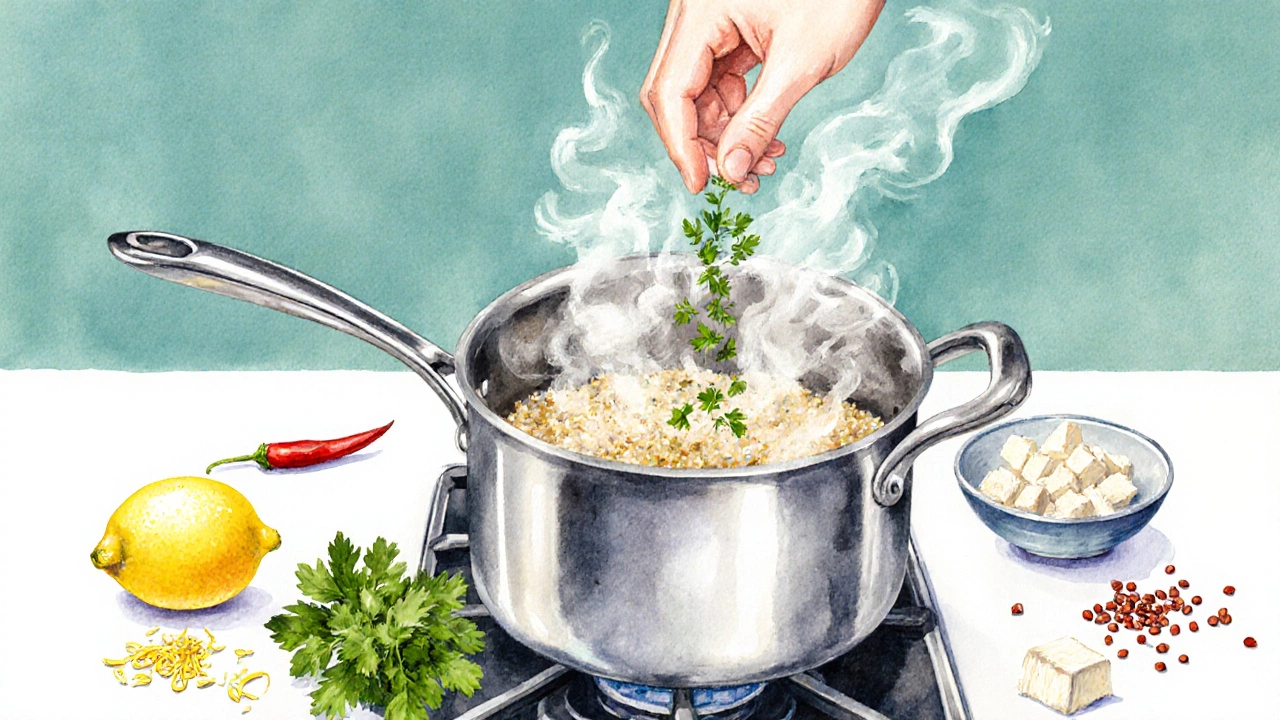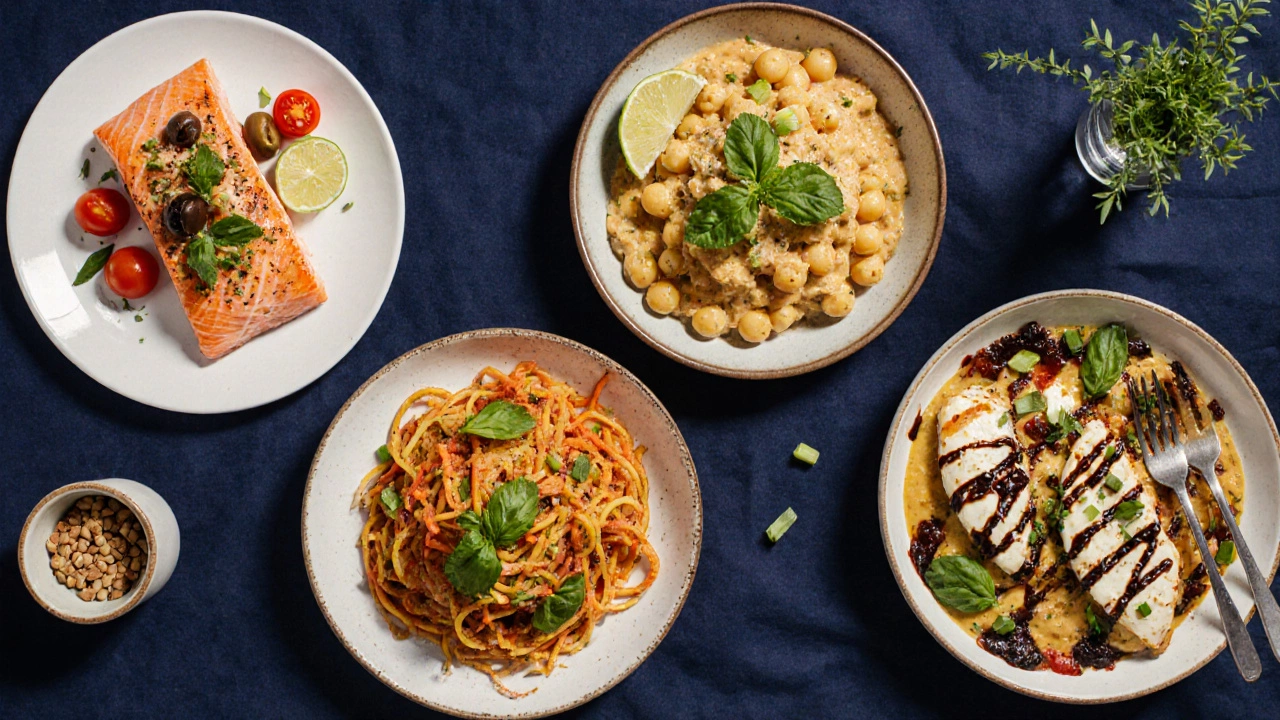Flavor Booster Recommender
Create a Flavor-Friendly Meal
Avoid taste fatigue by selecting the perfect flavor boosters for your main ingredient. This tool suggests herbs, spices, and sauces based on your preferences.
Ever find yourself scrolling through takeout menus only to think, "Nothing looks tasty right now"? It’s a common slump called taste fatigue, and it can turn any evening into a dreaded decision‑making marathon. The good news? A few smart tweaks and a handful of simple dishes can hit the reset button and make dinner feel exciting again.
What Causes Taste Fatigue?
Our palates are surprisingly sensitive to routine. When we eat the same sauces, spices, or cooking methods day after day, the brain starts to dampen the pleasure signals. Add a pinch of stress, a busy schedule, or a lack of fresh ingredients, and the whole eating experience feels flat.
Here are three quick culprits:
- Monotonous flavor profiles - Repeating the same sweet‑savory combo exhausts taste buds.
- Texture overload - Constantly chewing crunchy or soggy foods reduces satisfaction.
- Visual monotony - A plate that looks the same every night signals “meh” to the brain.
Understanding why the appetite wanes is the first step to fixing it.
Reset Your Palate in Five Simple Moves
Before pulling out a new recipe, try these fast palate‑reset tricks. They cost under $5 and take less than five minutes.
- Swap a seasoning: If you always use garlic powder, try smoked paprika or fresh ginger.
- Change the cooking method: Grill a chicken breast you’d normally bake, or sauté veggies you’d usually steam.
- Introduce a bright element: A squeeze of lime, a handful of fresh herbs, or a splash of vinaigrette can lift dull flavors.
- Play with texture: Toss in toasted nuts or crispy chickpea crumbs for crunch.
- Refresh the plate: Use a colored dish, a new garnish, or a different plating style to make the meal visually appealing.
These micro‑adjustments often restore interest faster than a whole new recipe.
Seven easy dinner recipes to Break the Rut
Below are seven dishes that require 30 minutes or less, use pantry staples, and incorporate at least two of the palate‑reset moves above.
1. Lemon‑Herb One‑Pot Quinoa
One-Pot Quinoa is a quick, nutrient‑dense grain dish that cooks everything in a single saucepan, saving time and dishes. Combine 1 cup rinsed quinoa, 2 cups water, the zest of one lemon, a handful of chopped parsley, and a pinch of red pepper flakes. Bring to a boil, reduce heat, and simmer 15 minutes. Finish with a drizzle of olive oil and a sprinkle of feta if you like.
2. Spicy Peanut Butter Noodles
Cook 8oz whole‑wheat spaghetti, drain, and toss with a sauce made from 2tbsp peanut butter, 1tbsp soy sauce, 1tsp sriracha, 1tsp honey, and a splash of rice vinegar. Add shredded carrots and sliced green onions for crunch and brightness. The nutty‑spicy combo jolts the taste buds.
3. Sheet‑Pan Mediterranean Salmon
Lay two salmon fillets on a parchment‑lined sheet pan. Scatter cherry tomatoes, sliced olives, and thin red onion wedges around them. Drizzle with olive oil, sprinkle dried oregano, and roast at 425°F for 12‑15 minutes. The caramelized veggies and herb‑infused salmon deliver a fresh, Mediterranean vibe.
4. Creamy Chickpea Curry (Vegan)
Sauté 1tsp cumin, 1tsp coriander, and ½tsp turmeric in coconut oil. Add a can of drained chickpeas, ½cup coconut milk, and a handful of spinach. Simmer 8 minutes, then finish with a squeeze of lime and a handful of fresh cilantro. The aromatic spices and citrus pop keep the palate engaged.
5. Quick Beef & Broccoli Stir‑Fry
Slice ½lb flank steak thinly. Stir‑fry in hot oil with garlic and ginger, then add broccoli florets and a sauce of 2tbsp oyster sauce, 1tbsp soy sauce, and 1tsp cornstarch mixed with water. Cook 3‑4 minutes until glossy. Serve over rice or cauliflower rice for a satisfying texture contrast.
6. Caprese Chicken Bake
Place chicken thighs in a baking dish, top with sliced mozzarella, halved cherry tomatoes, and fresh basil leaves. Bake at 400°F for 25 minutes, then drizzle with balsamic reduction. The classic Italian flavors are refreshed by the baked caramelization.
7. Veggie‑Loaded Breakfast Fried Rice
Use leftover rice. In a hot skillet, scramble two eggs, then set aside. Sauté diced bell pepper, peas, and corn, add the rice, a splash of soy sauce, and the scrambled eggs. Finish with chopped scallions and a dash of sesame oil. Breakfast flavors in a dinner setting keep things playful.

Flavor Boosters: Choose the Right Enhancer
When the same three herbs keep showing up in every dish, it’s time to expand your flavor toolbox. Below is a quick comparison of three popular booster categories.
| Category | Typical Uses | Key Benefits | Best Pairings |
|---|---|---|---|
| Herbs | Fresh finishes, salads, marinades | Bright, aromatic, low‑calorie | Lemon, olive oil, grilled meats |
| Spices | Dry rubs, stews, sauces | Depth, warmth, long‑term flavor | Tomato bases, beans, roasted veggies |
| Sauces | Quick dressings, glazing, dipping | Umami boost, texture variation | Stir‑fries, grilled fish, sandwiches |
Keep at least one item from each column in your pantry. Swapping a herb for a spice or a sauce can instantly transform a familiar recipe.
Meal Planning Hacks to Prevent Future Fatigue
Even the best recipes lose their sparkle if you repeat them too often. Here are three planning habits that keep dinner interesting without demanding extra time.
- Theme nights: Designate Mondays for Mexican, Thursdays for Asian, and Saturdays for comfort food. Rotate the cuisine each week.
- Ingredient batch‑swap: Cook a large batch of a base (like quinoa or roasted veggies) and pair it with different proteins or sauces on alternate nights.
- Flavor‑focus calendar: Each week, pick a new herb, spice, or sauce to spotlight. For example, week one highlights smoked paprika, week two tries harissa.
These small structures give you variety without forcing you to learn a brand‑new recipe every night.

Quick Checklist: Make Every Dinner Feel Good
- Switch at least one flavor element (herb, spice, sauce) per meal.
- Include a contrasting texture (crunch, creaminess, snap).
- Use a colorful plate or garnish to improve visual appeal.
- Rotate protein sources: chicken, fish, legumes, tofu.
- Plan a theme or flavor focus for the week.
Tick these boxes and you’ll notice your meals suddenly taste better, even on busy weeks.
Frequently Asked Questions
Why do I lose appetite for my usual meals?
Our brains quickly adapt to repeated flavors, making them feel less exciting. Stress, lack of variety, and monotone textures all contribute to a temporary drop in appetite.
Can I fix taste fatigue without buying new ingredients?
Yes. Simple swaps like changing the cooking method, adding fresh herbs, or incorporating a crunchy topping can revive flavor without a grocery trip.
How often should I rotate my dinner themes?
A weekly rotation works well for most people. It gives enough time to enjoy a cuisine while keeping the overall menu fresh.
What are the quickest ways to add crunch to a soft dish?
Toast nuts, sprinkle toasted breadcrumbs, or toss in roasted chickpeas. Even a handful of pomegranate seeds adds a surprising pop.
Are there any low‑effort sauces that work with many dishes?
A simple garlic‑lemon olive oil drizzle, a quick tahini‑soy mix, or a store‑bought pesto can instantly lift flavors across proteins, grains, and veggies.

